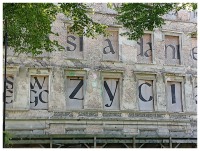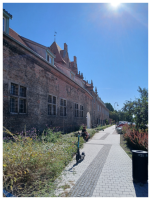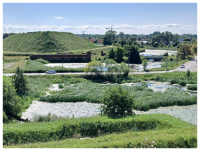Entry tags:
Travel Notes: Gdańsk - Day 4
Title: Travel Notes: Gdańsk
Author:![[personal profile]](https://www.dreamwidth.org/img/silk/identity/user.png) rodo
rodo
Chapter: 4/5
Length: 1319 words
Rating: 6+
Genre: travelogue
A/N: feel free to read; I wrote this mainly for myself, to better remember my time in Gdańsk
Summary: In the summer of 2024, I found myself with time and money to spend, and on short notice, decided to visit Gdańsk, a city I’d never been to, but had always wanted to see. Here, you can read all about my trip – the boring and hopefully not so boring details, illustrated by a couple of photos.
Day 4: Wednesday, 31st of July 2024: A Walk and Another Museum
I woke up with a headache. Again. Resigned to my fate, I resorted to my tried and true cure of two coffees at breakfast. I did not think to apply the blister band-aids before going down to the buffet, and it showed. I was walking as if on glass, and it took me a while to get from A to B.
When I left (again, later than I had wanted to), it was to check out the early modern fortifications at the southern end of the old city, which I hadn’t been to before. Walking there took me half an hour, so at some point I wondered if I might have gotten lost along the way. I passed the National Museum and the White Tower, then finally consulted my map in a tiny park – which told me I shouldn’t have bothered since I was almost there.
The two bastions aren’t much to look at if you’re interested in architecture. Mostly because there isn’t any left, barring a couple of decaying walls here and there poking out from the grass and dirt, as well as the stone lock. What is left amounts to two hills, which at that time of year were covered in wildflowers and flowering grass, which meant I had to pause quite a bit while climbing them to catch my semi-asthmatic breath. And then there is the moat.
If you’ve seen an early modern bastion fort or the remnants thereof, you can probably imagine what it all looked like: a vague star shape, rimmed with narrow canals. After the Bastion of Gertrude, I passed through the Lowland Gate (home to quite a few swallows) and climbed the Bastion of the Aurochs, which was quite empty except for one guy doing his morning callisthenics and another picking up trash. From there, I got a good look at the stone lock and the larger part of the moat. A plaque told me that there were cormorants, and when I walked away, I caught sight of a distinctive black silhouette on top of some flotsam in the distance. I’d never seen one in the wild before, even if my mother assures me that they’re quite common.
On my way back, I passed through a couple of residential neighbourhoods, a mix of some that are currently in the process of being revitalized (as per the large billboards put up), while others were pretty recent, nice city blocks that look quite comfortable. In one place, I walked past a couple grilling meat over an open fire next to an empty swing, a lot of tiny dogs were running around without supervision, and during my frequent breaks due to my allergies, I took pleasure in watching jackdaws scavenge for food.
Finally, I reached Granary Island, named so for obvious reasons, although the granaries were mostly destroyed in the war and the island is now covered in modern buildings, full of restaurants that look trendy to my untrained eye.
And of course, I went through St. Dominic’s Fair again. This time, I picked what I’d like to call the woo section: crystals, zodiac-themed jewellery, incense and the like. I bought myself something – because it’s incredibly tempting, the more you walk past the stalls. It was a very un-woo snowflake cookie stamp.
(I also bought myself another Pepsi Max Mango, from yet another Żabka.)
For that afternoon – my last one – I chose to visit the Amber Museum since the Bay of Gdańsk is the place in the world where you can find amber in unparalleled abundance. It was located quite close to my hotel, within the Grand Mill – a building that used to be, well, a great mill. It stayed in use as one more or less until its destruction in the war and has served several purposes after getting reconstructed. The building itself looked incredibly cool – so cool I’d already photographed it several times on the first day before I even knew what it was. The inside is a modern construction, with the damaged foundations being visible through a glass-covered hole in the floor. The Amber Museum moved to the Grand Mill only recently.
It’s not a large museum, by any means, but I liked it well enough. The first storey is dedicated to the science of amber. As such, it explains its origin as tree resin and showcases lumps of amber in its natural form – which can be quite huge. One was almost the size of a person’s head. It also explained the source of the colours (not the tree species, as you might assume, but rather impurities), which can range from, well, amber, as well as brown, red, black, green, white and even blue. There’s also something called “copal”, which is ancient resin as well, but younger and not quite fossilized yet.
The first storey was also the place where I found my favourite exhibit: a smallish piece of amber, containing a rather unusual inclusion: a tiny lizard, smaller than the dragonfly in the piece next to it, but looking incredibly life-like. A plaque nearby explained why the lizard would not help establish a pocket version of Jurassic Park: during the fossilization process, the inclusion is turned into nothing more than a husk of sorts – all liquid gets extracted from the inclusion.
As I walked on, the exhibits focussed on how humans acquired amber (by fishing, as it turns out, since amber floats; and more recently through mining), and what it was used for besides jewellery – namely incense and various medicinal uses. You too can cure your hysteria with pellets containing ground amber!
The second storey is dedicated to cultural artefacts made from amber. There’s modern art and jewellery, but also a lot more historical pieces, considering amber has been used by humans for millennia. There were recent-ish cigarette holders and pipes, boxes inlaid with amber panels, an intricate pin under a magnifying glass, small madonnas, and a chess set that once belonged to some duke or earl from Scotland who had been exiled following the Jacobite revolutions. And of course, there was a corner dedicated to speculation about the Amber Room.
Once I was done looking at the exhibits, I visited the gift shop, but while the pieces there were really beautiful, they were also very much out of my price range, so I left without even more shiny jewels.
When I left the museum, it was 16:30 and I was getting hungry. I went with Indian food again, this time going to the restaurant in the shopping mall near the hotel. It was good, if not as good as in the other restaurant (it was one of those restaurants that offered a range of Asian food of questionable authenticity), before setting off again to say goodbye to the city with one last stroll. I walked out and passed by a statue of Vladimir I, Grand Prince of Kyiv and saint credited with converting the Kyivan Rus’. It stands in front of a church dedicated to the Greek-Ukrainian branch of Catholicism. I’d walked past before, and there always seemed to be a mass happening.
On this last walk, I finally found the World War II Museum. It looked similar to the European Solidarity Centre, although I thought the style didn’t work in this context. I didn’t have the time to explore it now anyway.
When my feet got tired, I ended up sitting on a bench in front of the monument dedicated to the postal workers murdered in the war, where I chilled for a while, watching people walk past. I was fonder on the monument once I got a closer look at it, and the red and white flowers at the base were a nice touch. But all good things have to end, and it was time to go back to the hotel, to get ready for the next day. I had a lot of souvenirs to pack, after all.
Previous Chapter: Day 3: Tuesday, 30th of July 2024: Something New(ish) | Next chapter: Day 5: Thursday, 1st of August 2024: … That Ends Well



The Chapters
Day 1: Sunday, 28th of July 2024: All is well… | Day 2: Monday, 29th of July 2024: Getting Started | Day 3: Tuesday, 30th of July 2024: Something New(ish) | Day 4: Wednesday, 31st of July 2024: A Walk and Another Museum | Day 5: Thursday, 1st of August 2024: … That Ends Well
Author:
Chapter: 4/5
Length: 1319 words
Rating: 6+
Genre: travelogue
A/N: feel free to read; I wrote this mainly for myself, to better remember my time in Gdańsk
Summary: In the summer of 2024, I found myself with time and money to spend, and on short notice, decided to visit Gdańsk, a city I’d never been to, but had always wanted to see. Here, you can read all about my trip – the boring and hopefully not so boring details, illustrated by a couple of photos.
I woke up with a headache. Again. Resigned to my fate, I resorted to my tried and true cure of two coffees at breakfast. I did not think to apply the blister band-aids before going down to the buffet, and it showed. I was walking as if on glass, and it took me a while to get from A to B.
When I left (again, later than I had wanted to), it was to check out the early modern fortifications at the southern end of the old city, which I hadn’t been to before. Walking there took me half an hour, so at some point I wondered if I might have gotten lost along the way. I passed the National Museum and the White Tower, then finally consulted my map in a tiny park – which told me I shouldn’t have bothered since I was almost there.
The two bastions aren’t much to look at if you’re interested in architecture. Mostly because there isn’t any left, barring a couple of decaying walls here and there poking out from the grass and dirt, as well as the stone lock. What is left amounts to two hills, which at that time of year were covered in wildflowers and flowering grass, which meant I had to pause quite a bit while climbing them to catch my semi-asthmatic breath. And then there is the moat.
If you’ve seen an early modern bastion fort or the remnants thereof, you can probably imagine what it all looked like: a vague star shape, rimmed with narrow canals. After the Bastion of Gertrude, I passed through the Lowland Gate (home to quite a few swallows) and climbed the Bastion of the Aurochs, which was quite empty except for one guy doing his morning callisthenics and another picking up trash. From there, I got a good look at the stone lock and the larger part of the moat. A plaque told me that there were cormorants, and when I walked away, I caught sight of a distinctive black silhouette on top of some flotsam in the distance. I’d never seen one in the wild before, even if my mother assures me that they’re quite common.
On my way back, I passed through a couple of residential neighbourhoods, a mix of some that are currently in the process of being revitalized (as per the large billboards put up), while others were pretty recent, nice city blocks that look quite comfortable. In one place, I walked past a couple grilling meat over an open fire next to an empty swing, a lot of tiny dogs were running around without supervision, and during my frequent breaks due to my allergies, I took pleasure in watching jackdaws scavenge for food.
Finally, I reached Granary Island, named so for obvious reasons, although the granaries were mostly destroyed in the war and the island is now covered in modern buildings, full of restaurants that look trendy to my untrained eye.
And of course, I went through St. Dominic’s Fair again. This time, I picked what I’d like to call the woo section: crystals, zodiac-themed jewellery, incense and the like. I bought myself something – because it’s incredibly tempting, the more you walk past the stalls. It was a very un-woo snowflake cookie stamp.
(I also bought myself another Pepsi Max Mango, from yet another Żabka.)
For that afternoon – my last one – I chose to visit the Amber Museum since the Bay of Gdańsk is the place in the world where you can find amber in unparalleled abundance. It was located quite close to my hotel, within the Grand Mill – a building that used to be, well, a great mill. It stayed in use as one more or less until its destruction in the war and has served several purposes after getting reconstructed. The building itself looked incredibly cool – so cool I’d already photographed it several times on the first day before I even knew what it was. The inside is a modern construction, with the damaged foundations being visible through a glass-covered hole in the floor. The Amber Museum moved to the Grand Mill only recently.
It’s not a large museum, by any means, but I liked it well enough. The first storey is dedicated to the science of amber. As such, it explains its origin as tree resin and showcases lumps of amber in its natural form – which can be quite huge. One was almost the size of a person’s head. It also explained the source of the colours (not the tree species, as you might assume, but rather impurities), which can range from, well, amber, as well as brown, red, black, green, white and even blue. There’s also something called “copal”, which is ancient resin as well, but younger and not quite fossilized yet.
The first storey was also the place where I found my favourite exhibit: a smallish piece of amber, containing a rather unusual inclusion: a tiny lizard, smaller than the dragonfly in the piece next to it, but looking incredibly life-like. A plaque nearby explained why the lizard would not help establish a pocket version of Jurassic Park: during the fossilization process, the inclusion is turned into nothing more than a husk of sorts – all liquid gets extracted from the inclusion.
As I walked on, the exhibits focussed on how humans acquired amber (by fishing, as it turns out, since amber floats; and more recently through mining), and what it was used for besides jewellery – namely incense and various medicinal uses. You too can cure your hysteria with pellets containing ground amber!
The second storey is dedicated to cultural artefacts made from amber. There’s modern art and jewellery, but also a lot more historical pieces, considering amber has been used by humans for millennia. There were recent-ish cigarette holders and pipes, boxes inlaid with amber panels, an intricate pin under a magnifying glass, small madonnas, and a chess set that once belonged to some duke or earl from Scotland who had been exiled following the Jacobite revolutions. And of course, there was a corner dedicated to speculation about the Amber Room.
Once I was done looking at the exhibits, I visited the gift shop, but while the pieces there were really beautiful, they were also very much out of my price range, so I left without even more shiny jewels.
When I left the museum, it was 16:30 and I was getting hungry. I went with Indian food again, this time going to the restaurant in the shopping mall near the hotel. It was good, if not as good as in the other restaurant (it was one of those restaurants that offered a range of Asian food of questionable authenticity), before setting off again to say goodbye to the city with one last stroll. I walked out and passed by a statue of Vladimir I, Grand Prince of Kyiv and saint credited with converting the Kyivan Rus’. It stands in front of a church dedicated to the Greek-Ukrainian branch of Catholicism. I’d walked past before, and there always seemed to be a mass happening.
On this last walk, I finally found the World War II Museum. It looked similar to the European Solidarity Centre, although I thought the style didn’t work in this context. I didn’t have the time to explore it now anyway.
When my feet got tired, I ended up sitting on a bench in front of the monument dedicated to the postal workers murdered in the war, where I chilled for a while, watching people walk past. I was fonder on the monument once I got a closer look at it, and the red and white flowers at the base were a nice touch. But all good things have to end, and it was time to go back to the hotel, to get ready for the next day. I had a lot of souvenirs to pack, after all.


